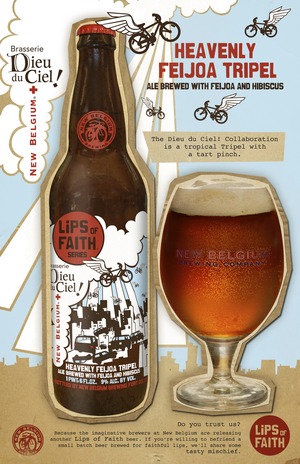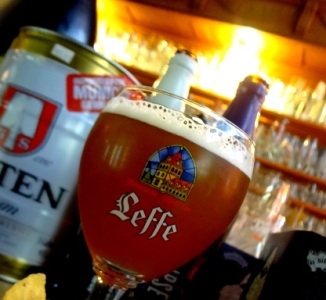 TRADITIONAL BELGIAN tripels are remarkable for many reasons, not least among them the complexity they extract from a modicum of ingredients. Heavenly Feijoa, a recent Lips of Faith collaboration between New Belgium Brewing and Dieu du Ciel!, is the antithesis of such economy. With hibiscus, feijoa juice, pungent New Zealand hops, and even a small dose of black malt, this 9.4% ABV tripel risked being a garish waste of ‘artisanal’ ingredients. Yet all these strange tweaks share a common thread, revealing the conscientious craftsmanship that drives this series—a refreshing reminder after a string of seemingly haphazard disappointments—and the results are rather charming.
TRADITIONAL BELGIAN tripels are remarkable for many reasons, not least among them the complexity they extract from a modicum of ingredients. Heavenly Feijoa, a recent Lips of Faith collaboration between New Belgium Brewing and Dieu du Ciel!, is the antithesis of such economy. With hibiscus, feijoa juice, pungent New Zealand hops, and even a small dose of black malt, this 9.4% ABV tripel risked being a garish waste of ‘artisanal’ ingredients. Yet all these strange tweaks share a common thread, revealing the conscientious craftsmanship that drives this series—a refreshing reminder after a string of seemingly haphazard disappointments—and the results are rather charming.
The beer’s looks are traditional, if a little underwhelming: golden, a little hazy, and with a thin layer of white head but no lasting bubbles. The aroma blends ginger snap and lemon with an unexpected twist of tart berry coming from the feijoa juice, presumably bolstered by almost winey Nelson Sauvin hops. That bouquet presages a surprisingly tart, forward-focused flavor that shifts its focus from citrus early to berries late. Yeast and malt are more apparent in between, though more for the other flavors’ waning than their own waxing. Marked as Best Before March 2014, the beer’s has clearly smoothed considerably since its bottling—at that time a spicier midsection and more assertive effervescence would likely have helped keep its distinctive corners pinned up neatly. Carbonation remains fairly high, though, with small and creamy bubbles carrying smoothly from front to back and leaving the finish fairly clean, if not especially lasting. The beer’s body is likely a little fuller than most tripels, too, and the juice likely didn’t ferment out quite as cleanly as the traditional adjunct of candi sugar. Perhaps that aging has also diminished the alcohol presence, since a 9.4% ABV is rarely so unobtrusive, especially in a tripel. The ultimate balance is well-struck between mild titillation and simply good refreshment.
Served: 750 ml bottle best before March 2014
Rating: 85








 TRADITIONAL IN FOUNDATION, American in accentuation, Allagash’s Tripel is a solid indicator of their brewery at large. Instantly recognizable as a tripel for its bountiful head, hazy golden color, 9% ABV, etc., and definitely in the prominence of yeast. No surprises there, given their pedigree in refermented ales. The twist comes through in the expression of the yeast itself (a different bottling yeast than the one used for fermenting all their ales), which is distinctively reminiscent of grapefruit and passionfruit more so than the more common (and still present) citrus or banana. This gives the brew an almost tropical edge, which combines well with its slightly heavier than average body. Phenols fairly prominent towards the end along with some clove and spice, but the fruit zest still is the lingering impression, even after the decisive carbonation dissipation.
TRADITIONAL IN FOUNDATION, American in accentuation, Allagash’s Tripel is a solid indicator of their brewery at large. Instantly recognizable as a tripel for its bountiful head, hazy golden color, 9% ABV, etc., and definitely in the prominence of yeast. No surprises there, given their pedigree in refermented ales. The twist comes through in the expression of the yeast itself (a different bottling yeast than the one used for fermenting all their ales), which is distinctively reminiscent of grapefruit and passionfruit more so than the more common (and still present) citrus or banana. This gives the brew an almost tropical edge, which combines well with its slightly heavier than average body. Phenols fairly prominent towards the end along with some clove and spice, but the fruit zest still is the lingering impression, even after the decisive carbonation dissipation.
